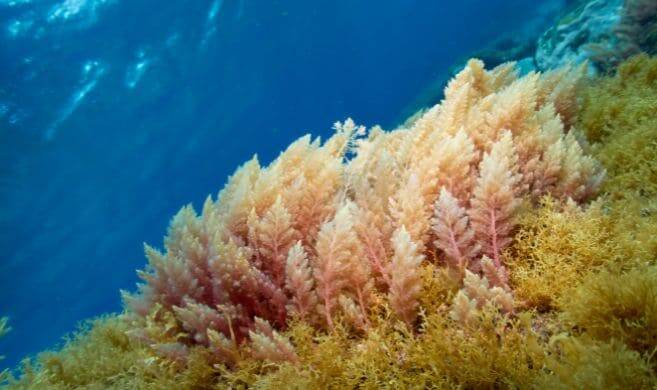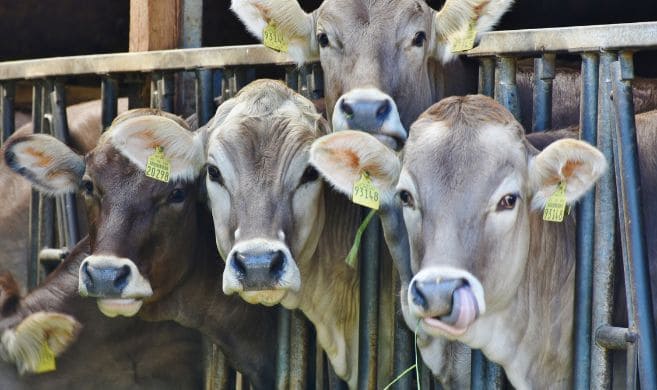Asparagopsis taxiformis, a tropical red seaweed, has gained scientific and public traction in recent years for its potential to reduce the methane emissions of cattle significantly when added to their feed. Impressive figures and promising claims have made headlines, such as "Feeding cows seaweed could cut their methane emissions by 82%, scientists say" (The Guardian, 2021) and "adding just a bit to livestock feed cut cows' methane emissions by nearly 80 percent with no negative side effects" (Inc. magazine, 2022). The New York Times (2023) reports, "a sprinkle of Asparagopsis in cattle feed can cut methane from their burps by between 82 and 98 percent, according to several independent studies… It could be critical to the beef and dairy industry's ability to meet climate goals”. The solution has also been featured in the Financial Times article on 'how to feed 10 billion people sustainably' and as part of Project Drawdown to help stop climate change.
With such promising statements and impressive references, seaweed does really seem like a miracle solution!
However, despite these attention-grabbing claims, an in-depth analysis of the feasibility, desirability, and viability of using this seaweed as a decarbonization solution is needed.
I interviewed a wide range of experts, including seaweed producers, animal feed manufacturers, distributors, commercial partners, representatives from national livestock institutes, and carbon accounting specialists. And this is what I found.
Desirability: The Hidden Environmental Impact of Seaweed
The aquatic biodiversity impact of Asparagopsis taxiformis is unknown, and research is needed to understand its potential effects, especially when grown at scale. There is a risk of it becoming invasive if grown outside its native habitat. Furthermore, there are no rigorous studies on the net GHG mitigation impact considering the CO2 emissions produced throughout the production, processing, and transportation of the seaweed and feed supplement. This will likely offset even the carbon sequestered as seaweed photosynthesizes and grows. In addition, certain toxic compounds naturally released during the growth of Asparagopsis contribute to the depletion of the ozone layer. With small-scale production, the impact is negligible, but large-scale production requires careful monitoring.
There are no rigorous studies on the net GHG mitigation impact considering the CO2 emissions produced throughout the production, processing, and transportation of the seaweed and feed supplement.
Feasibility: Challenges in Seaweed Production
The feasibility of large-scale production remains a big question mark. No one has grown Asparagopsis taxiformis commercially, and regrowth requires wild stock, which risks bringing in disease and makes production dependent on natural fluctuations in wild stock volumes and quality. Furthermore, Asparagopsis is fragile and takes 10 -11 months to grow, which is relatively long. Currently, there are only a few pilots in progress, mostly in Australia, New Zealand, and Hawaii. Moreover, this ‘miracle' seaweed cannot be grown in European waters due to inadequate environmental conditions and biosecurity regulations. Scaling up production in tanks on land would be the only way to produce it ‘locally’ in Europe, but this is estimated to be 2-4 times more expensive than ocean aquaculture. Furthermore, integrating seaweed into existing animal feed presents a significant R&D challenge.
This particular ‘miracle’ seaweed cannot be grown in European waters due to inadequate environmental conditions and biosecurity regulations.
Viability: The hurdles to competitive commercialization and financing
The viability of using Asparagopsis taxiformis as a decarbonization solution depends on the development of new supply chains, the cost of production, and regulatory approval. Currently, the price of seaweed is estimated to be 3-4 times more expensive than synthetic competitors (such as Bovaer® manufactured by the chemical multinational DSM) and the cost is expected to fluctuate depending on production volumes. Financing through carbon credits is a possibility, but more extensive research on its effectiveness, especially long-term, is needed for integration into European carbon accounting tools (such as CAP’2ER) and carbon credit regulatory bodies. Farmers and dairy corporates are also still concerned about the potential side effects of Asparagopsis on animal health, productivity, and meat and milk quality. And ultimately, this seaweed won’t be able to have an impact until it is approved as a feed additive for commercial use in Europe. Yet, the reality is that many uncertainties and risks remain to be cleared before authorization could be granted.
It is essential to recognize that relying solely on technological solutions like Asparagopsis taxiformis will not be enough to mitigate the environmental impact of the livestock sector.
Conclusion
While Asparagopsis taxiformis shows potential in reducing methane emissions in the livestock sector, the feasibility, desirability, and viability of using it as a decarbonization solution are complex and uncertain, based on interviews with a wide range of experts. More research, investment, and regulatory approval are needed to understand the benefits and drawbacks of this solution fully. Furthermore, it is essential to recognize that relying solely on technological solutions like Asparagopsis taxiformis will not be enough to mitigate the environmental impact of the livestock sector. Instead, a more comprehensive approach that includes promoting sustainable farming practices, improving manure management, and encouraging a shift towards more plant-based diets is necessary. While seaweed has the potential to contribute to a more sustainable livestock industry in certain regions, it should be considered in a context specific way and as part of a broader set of strategies to address climate change and protect our planet for the current and future generations.
A special thank you to Simon Haller, fellow at the MSc Sustainability & Social Innovation student, with whom I worked with in the student-incubator program HEC Startup Launchpad on this subject, inspiring this thesis.









